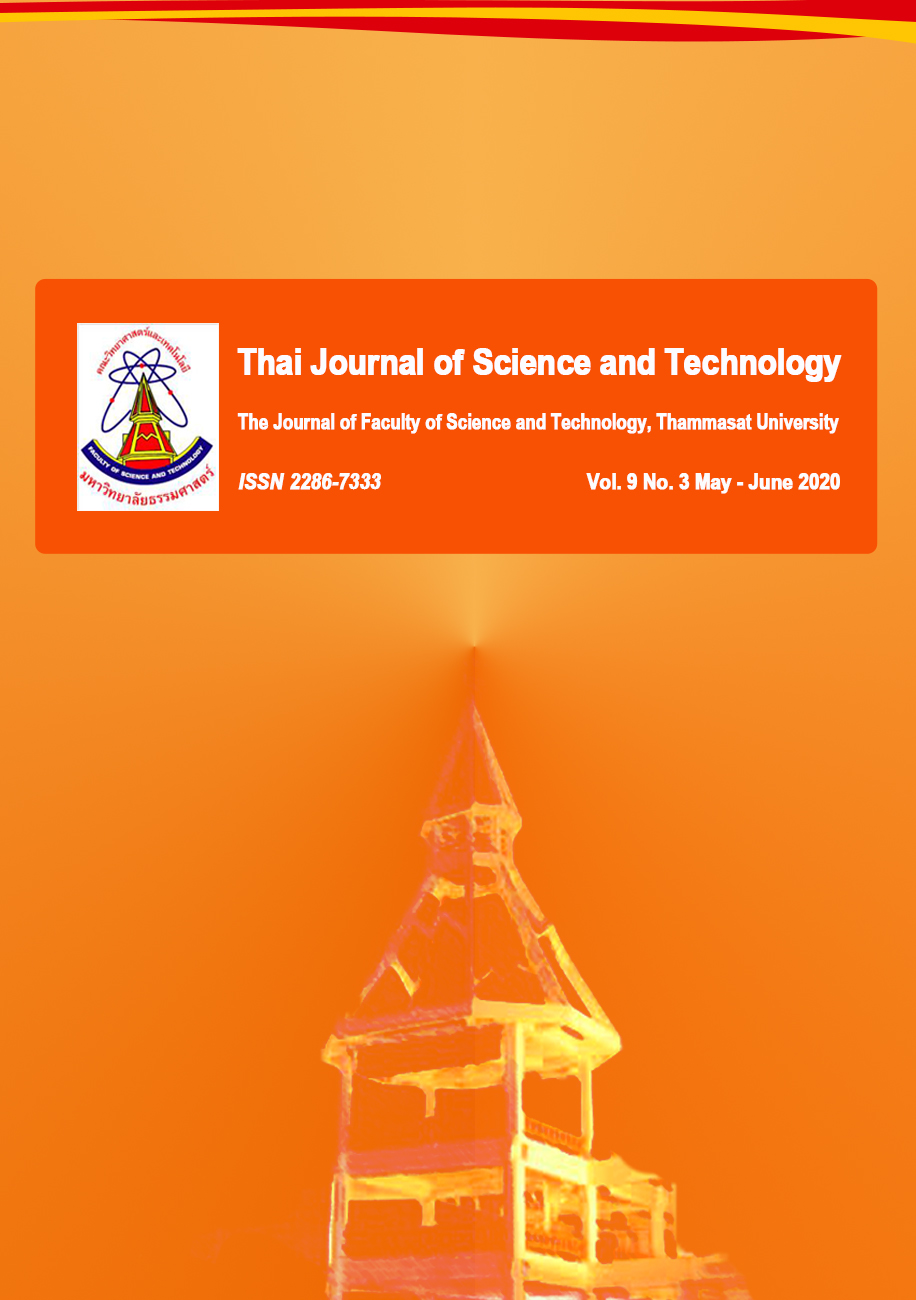ผลของแคลเซียมซิลิเกตจากอุตสาหกรรมซีเมนต์ต่อการเจริญเติบโตและการตอบสนองกระบวนการทางสรีรวิทยาของข้าวเหนียวพันธุ์ กข-แม่โจ้ 2 ภายใต้สภาวะขาดน้ำ
Main Article Content
Abstract
Water deficiency is the most important effect on growth and physiological responses of glutinous rice, which is affected to its quantity and quality. The aim of this study was to estimate an effect of calcium silicate from cement industry on growth and yield of glutinous rice cv. RD-Mae Jo 2 under different water supplies. The experiment was undertaken in 3×5 factorial in completely randomized design. The study factors were; (1) different water supplies, (100, 50 and 25 % of moisture at soil saturated with water), and (2) calcium silicate (0, 50, 150, 300 and 400 Kg/rai). The result showed that decreased water supply affected rice cv. RD-Mae Jo 2; growth (plant height, leaf width, leaf length and tiller number per plant), stomatal conductance and respiration rate were decreased, while the photosynthetic rate was increased. Decreased water supply to 50% with calcium silicate 400 Kg per rai promoted growth characteristics such as height, leaf length and tiller number per plant (significantly higher than those of non-calcium silicate). Moreover, photosynthetic rate was highest and trended to decrease respiration rate when compared to decreased water supply to 50% with non-calcium silicate. Therefore, calcium silicate from cement industry can be used to replace expensive silicon fertilizer and to alleviate stress caused by water deficiency of rice.
Article Details
บทความที่ได้รับการตีพิมพ์เป็นลิขสิทธิ์ของคณะวิทยาศาสตร์และเทคโนโลยี มหาวิทยาลัยธรรมศาสตร์ ข้อความที่ปรากฏในแต่ละเรื่องของวารสารเล่มนี้เป็นเพียงความเห็นส่วนตัวของผู้เขียน ไม่มีความเกี่ยวข้องกับคณะวิทยาศาสตร์และเทคโนโลยี หรือคณาจารย์ท่านอื่นในมหาวิทยาลัยธรรมศาสตร์ ผู้เขียนต้องยืนยันว่าความรับผิดชอบต่อทุกข้อความที่นำเสนอไว้ในบทความของตน หากมีข้อผิดพลาดหรือความไม่ถูกต้องใด ๆ
References
บุญสม เตชะภิญญาวัฒน์, 2548, สรีรวิทยาของพืช, พิมพ์ครั้งที่ 4, สำนักพิมพ์จามจุรีโปรดักท์, กรุงเทพฯ, 252 น.
บุญหงษ์ จงคิด, 2547, ข้าวและเทคโนโลยีการผลิต, สำนักพิมพ์มหาวิทยาลัยธรรมศาสตร์, กรุงเทพฯ, 184 น.
ปิยะ ดวงพัตรา, 2554, สารปรับปรุงดิน, พิมพ์ครั้งที่ 2, สำนักพิมพ์มหาวิทยาลัยเกษตรศาสตร์, กรุงเทพฯ, 256 น.
มานัส ลอศิริกุล, นันทิยา หุตานุวัตร, นพมาศ นามแดง, สุกัญญา คลังศิริกุล และประสิทธิ์ กาญจนา, 2558, ศักยภาพในการให้ผลผลิตข้าวเหนียวพื้นเมืองโดยใช้ปุ๋ยชีวภาพและน้ำหมักชีวภาพในพื้นที่นาดินทรายปนร่วนของเกษตรกร ฤดูนาปรังปี 2555, แก่นเกษตร 43(1): 39-52.
ยงยุทธ โอสถสภา, 2552, ธาตุอาหารพืช, พิมพ์ครั้งที่ 3, สำนักพิมพ์มหาวิทยาลัยเกษตรศาสตร์, กรุงเทพฯ, 529 น.
วารสารแม่โจ้ปริทัศน์, 2555, ข้าวเหนียวหอมต้นเตี้ยไม่ไวต่อช่วงแสงสายพันธุ์แม่โจ้ 2, 4: 12-16.
ศูนย์เมล็ดพันธุ์ข้าวขอนแก่น, กข-แม่โจ้ 2, แหล่งที่มา : http://kknrsc.ricethailand.go.th/index.php/e-library/varieties/311-rd-maejo-2, 7 สิงหาคม 2562.
สถาบันวิจัยข้าว, 2547, คำแนะนำการใช้ปุ๋ยเคมีในนาข้าวตามค่าวิเคราะห์ดิน, กรมวิชาการเกษตร, กรุงเทพฯ, 41 น.
สมชาย ชคตระการ, พักตร์เพ็ญ ภูมิพันธ์ และอรประภา เทพศิลปวิสุทธิ์, 2560, ผลของการใช้วัสดุเหลือทิ้งจากอุตสาหกรรมผลิตซีเมนต์ต่อการเจริญเติบโตและผลผลิตข้าวพันธุ์ปทุมธานี 1, ว.วิทยาศาสตร์และเทคโนโลยี 25(1): 66-74.
เวธนี วัฒนเดชเสรี, สมชาย ชคตระการ, พักตร์เพ็ญ ภูมิพันธ์ และพฤกษ์ ชุติมานุกูล, 2561, ผลของซิลิกอนจากอุตสาหกรรมซีเมนต์ต่อการเจริญเติบโตและผลผลิตของข้าวพันธุ์ปทุมธานี 1 ภายใต้ระดับการให้น้ำที่แตกต่างกัน, Thai J. Sci. Technol. 8(1): 31-42.
Emadian, S.F. and Newton, R.J., 1989, Growth enhancement of loblollypine (Pinus taeda L.) seedlings by silicon, Plant Physiol. 134: 98-103.
Gong, H.J., Zhu, X.Y., Chen, K.M., Wang, S. and Zhang, C.L., 2005, Silicon alleviates oxidative damage of wheat plants in pots under drought, Plant Sci. 169: 313-321.
Hattori, T., Sonobe K., Araki, H., Inanaga, S., An, P. and Morita, S., 2008, Effects of silicon on photosynthesis of young cucumber seedling under osmotic stress, J. Plant Nutr. 31: 1446-1458.
Kumar, S., Dwivedi, S.K., Singh, S.S., Bhatt, B.P., Mehta, P., Elanchezhian, R., Singh, V.P. and Singh, O.N., 2014, Morphophysio logical traits associated with reproductive stage drought tolerance of rice (Oryza sativa L.) genotypes under rain-fed condition of eastern Indo-Gangetic Plain, Ind. J. Plant Physiol. 19(2): 87-93.
Ma, J.F. and Takahashi, E., 2002, Soil Fertilizer and Plant Silicon Research in Japan, Elsevier Science, Amsterdam.
Maisura, M.A.C., Lubis, I., Junaedinand, A. and Ehara, H., 2014, Some physiological character responses of rice under drought conditions in a paddy system, J. Int. Soc. Southeast Asian Agric. Sci. 20: 104-114.
Serraj, R., Kumar, A., McNally, K.L., Slamet-Loedin, I., Bruskiewich, R., Mauleon, R., Cairns, J. and Hijmans, R.J., 2009, Improvement of drought resistance in rice, Adv. Agron. 103: 41-98.
Raven, J.A., 1983, The transport and function of silicon in plants, Biol. Rev. Camb. Philos. Soc. 58: 179-207.
Wang, Y., Zhang, B., Jiang, D. and Chen, G., 2019, Silicon improves photosynthetic performance by optimizing thylakoid membrane protein components in rice under drought stress, Environ. Exp. Bot. 158: 117-124.
Zhang, C., Li, X., He, Y., Zhang, J., Yan, T. and Liu, X., 2017, Physiological investigation of C4-phosphoenolpyruvate-carboxylase-introduced rice line shows that sucrose metabolism is involved in the improved drought tolerance, Plant Physiol. 115: 328-342.


